How to build wires in a socket
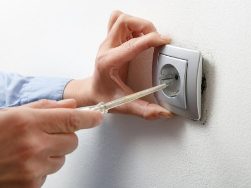 Replacing the outlet is simple, but not always everything goes as you want. It often happens that you can’t just take and plug in a new outlet, because the length of the old wires is not enough. They can break off or simply the design of the new outlet is different and it is not possible to clamp the wires normally. In this article, we will look at ways to lengthen short wires.
Replacing the outlet is simple, but not always everything goes as you want. It often happens that you can’t just take and plug in a new outlet, because the length of the old wires is not enough. They can break off or simply the design of the new outlet is different and it is not possible to clamp the wires normally. In this article, we will look at ways to lengthen short wires.
Wires and cables can have single-wire cores - these are cores that consist of a single solid wire, they are called rigid or monolithic cores. Frequent bending may break. Another type - multi-wire veins - they are soft, consist of several thin wires. It is often called stranded or flexible to bend such wires. The number of wires depends on the flexibility class of the core - the higher it is, the more wires. How does this relate to the extension of wires in the outlet? The fact is that the method of connecting them depends on the type of cores ...
What is a thermocouple and how does it work
 Thermocouples exist due to such a phenomenon as contact potential difference. If two different solid conductors or semiconductors are brought into close contact with each other, then separated electric charges are formed in the vicinity of the place of their contact. In this case, at the external ends of these conductors a potential difference will occur. This potential difference will be equal to the difference in the work function for each metal divided by the electron charge.
Thermocouples exist due to such a phenomenon as contact potential difference. If two different solid conductors or semiconductors are brought into close contact with each other, then separated electric charges are formed in the vicinity of the place of their contact. In this case, at the external ends of these conductors a potential difference will occur. This potential difference will be equal to the difference in the work function for each metal divided by the electron charge.
It is clear that if you close such a pair into a ring, the resulting EMF will be zero, but if on the one hand it is still left open, then there will be a real EMF, ranging from tenths of a volt to units of volts, depending on what this is for the materials. Of course, it is not possible to measure the contact potential difference with a voltmeter, however, it will show itself on the current-voltage characteristic, for example, it manifests itself in the transistor and in the diode at the p-n junction ...
How to choose a storage water heater
 Hot water has become the norm in a modern house. In large cities, hot water is supplied centrally, while in the provinces people were either never heard of or had already forgotten. Even where there is a centralized hot water supply during the period of preventive maintenance, water can be turned off for a period of several days to several months. To create comfortable conditions and not depend on this factor, you need to install a water heater. In this article, we will consider the selection criteria and the design of a storage water heater.
Hot water has become the norm in a modern house. In large cities, hot water is supplied centrally, while in the provinces people were either never heard of or had already forgotten. Even where there is a centralized hot water supply during the period of preventive maintenance, water can be turned off for a period of several days to several months. To create comfortable conditions and not depend on this factor, you need to install a water heater. In this article, we will consider the selection criteria and the design of a storage water heater.
Water heaters are by source of energy: gas, electric, other types of fuel. By type of heating and water movement: Flowing. For example, a gas water heater or an electric flow heater. In them, the water heats up when it flows through the heat exchanger. Cumulative. For example, a boiler, it is a water tank. In them, a certain amount of water is heated gradually. Heating time depends on power ...
Levitation and the Biffeld-Brown effect, ionic wind - how it works
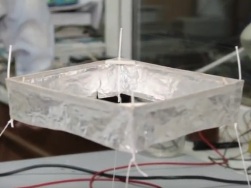 Aluminum food foil and the finest copper wire, and between them - only 3 centimeters of air. The foil and wire are mounted on a square dielectric frame made of light plastic sticks. The design rests on the table, and like any object, gravity acts on it from the side of the Earth. But it is worth creating a potential difference of several thousand volts between the foil and the wire, applying a high constant voltage of about 30,000 volts from a low-power source to it, as the structure takes off, as if by magic.
Aluminum food foil and the finest copper wire, and between them - only 3 centimeters of air. The foil and wire are mounted on a square dielectric frame made of light plastic sticks. The design rests on the table, and like any object, gravity acts on it from the side of the Earth. But it is worth creating a potential difference of several thousand volts between the foil and the wire, applying a high constant voltage of about 30,000 volts from a low-power source to it, as the structure takes off, as if by magic.
We are not talking about a take-off capacitor, because the plates, if you can call them that at all, almost do not overlap each other in any significant fraction of their areas, which means that practically no energy accumulation in the dielectric between the "plates" occurs. If the structure did not hold the thinnest strong strings on the table, it would continue its progressive movement ...
 Even the best, original and true field effect transistors always fail for the same reason - due to exceeding one of its maximum permissible parameters. We will not take into account mechanical damage to the cases and legs, instead, we note two main harmful factors - violation of the thermal regime and excess of critical voltage. Violation of the thermal regime means the excess of the permissible temperature of the crystal, which is usually directly related to the increased current, so we will consider in detail this aspect of the problem.
Even the best, original and true field effect transistors always fail for the same reason - due to exceeding one of its maximum permissible parameters. We will not take into account mechanical damage to the cases and legs, instead, we note two main harmful factors - violation of the thermal regime and excess of critical voltage. Violation of the thermal regime means the excess of the permissible temperature of the crystal, which is usually directly related to the increased current, so we will consider in detail this aspect of the problem.
Generally speaking, we can say that the field effect transistor fails either from overvoltage or from overheating. And if there are no reasons for exceeding the permissible parameters, then the transistor will retain both its operability and the operability of neighboring components, not to mention the nerve cells of the owner of the device for which this transistor was intended ...
How to distinguish an induction motor from a DC motor
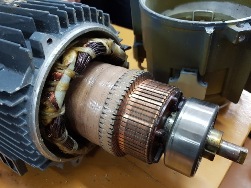 Asynchronous motors are motors in the process of operation of which a sliding phenomenon is observed under load, that is, a “lag” of the rotor rotation from the rotation of the stator magnetic field. In other words, the rotor rotates not synchronously with the rotation of the stator magnetization, but asynchronously with respect to this movement. That is why these types of motors are called asynchronous (non-synchronous) motors.
Asynchronous motors are motors in the process of operation of which a sliding phenomenon is observed under load, that is, a “lag” of the rotor rotation from the rotation of the stator magnetic field. In other words, the rotor rotates not synchronously with the rotation of the stator magnetization, but asynchronously with respect to this movement. That is why these types of motors are called asynchronous (non-synchronous) motors.
In most cases, pronouncing the phrase “asynchronous motor”, they mean the brushless AC motor. The slip value of an induction motor can be different depending on the load, as well as on the power parameters and the method of controlling the stator winding currents. If we are dealing with a conventional AC motor, such as AIR712A, then with a synchronous frequency of rotation of the magnetic field of 3000 rpm, under conditions of nominal mechanical load ...
Why are the wires of the power lines noisy
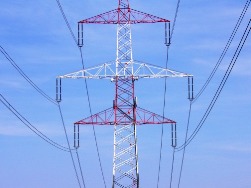 Why are the wires of the power transmission line humming? Have you ever thought about this? But the answer to this question can be by no means trivial, although completely unsophisticated. Let's look at several explanations, each of which has a right to exist.
Why are the wires of the power transmission line humming? Have you ever thought about this? But the answer to this question can be by no means trivial, although completely unsophisticated. Let's look at several explanations, each of which has a right to exist.
Most often give such an idea. An alternating electric field near the power line wire electrifies the air around the wire, accelerates free electrons, which ionize the air molecules, and they in turn generate a corona discharge. And now, a corona discharge around the wire lights up and goes out 100 times per second, while the air near the wire heats up - cools down, expands - contracts, and in this way we get a sound wave in the air, which our ear perceives as a buzzing wire. Still there is such an idea. The noise comes from the fact that an alternating current with a frequency of 50 Hz produces an alternating magnetic field ...
How to calculate battery charger settings
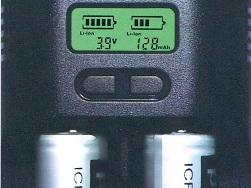 To calculate the parameters of the charger for a particular battery, you must first take into account the type and parameters of the battery that you are going to charge with this device. The most important characteristics of a rechargeable battery are: capacity, full charge voltage, maximum allowable charge current, as well as a range of permissible operating temperatures.
To calculate the parameters of the charger for a particular battery, you must first take into account the type and parameters of the battery that you are going to charge with this device. The most important characteristics of a rechargeable battery are: capacity, full charge voltage, maximum allowable charge current, as well as a range of permissible operating temperatures.
Depending on what kind of battery it is, what type of materials it uses - the parameters of the charger should be selected individually. Here we look at lead-acid and lithium-ion batteries, or rather the features of their charging. The truth is that if the battery is always charged correctly, in compliance with the optimal values of voltage and current, then it will retain its capacity for many charge-discharge cycles. Of course, provided that it is also discharged, subject to restrictions ...
